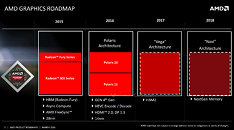Wednesday, April 20th 2016

AMD's GPU Roadmap for 2016-18 Detailed
AMD finalized the GPU architecture roadmap running between 2016 and 2018. The company first detailed this at its Capsaicin Event in mid-March 2016. It sees the company's upcoming "Polaris" architecture, while making major architectural leaps over the current-generation, such as a 2.5-times performance/Watt uplift and driving the company's first 14 nanometer GPUs; being limited in its high-end graphics space presence. Polaris is rumored to drive graphics for Sony's upcoming 4K Ultra HD PlayStation, and as discrete GPUs, it will feature in only two chips - Polaris 10 "Ellesmere" and Polaris 11 "Baffin."
"Polaris" introduces several new features, such as HVEC (h.265) decode and encode hardware-acceleration, new display output standards such as DisplayPort 1.3 and HDMI 2.0; however, since neither Polaris 10 nor Polaris 11 are really "big" enthusiast chips that succeed the current "Fiji" silicon, will likely make do with current GDDR5/GDDR5X memory standards. That's not to say that Polaris 10 won't disrupt current performance-thru-enthusiast lineups, or even have the chops to take on NVIDIA's GP104. First-generation HBM limits the total memory amount to 4 GB over a 4096-bit path. Enthusiasts will have to wait until early-2017 for the introduction of the big-chip that succeeds "Fiji," which will not only leverage HBM2 to serve up vast amounts of super-fast memory; but also feature a slight architectural uplift. 2018 will see the introduction of its successor, codenamed "Navi," which features an even faster memory interface.
Source:
VideoCardz
"Polaris" introduces several new features, such as HVEC (h.265) decode and encode hardware-acceleration, new display output standards such as DisplayPort 1.3 and HDMI 2.0; however, since neither Polaris 10 nor Polaris 11 are really "big" enthusiast chips that succeed the current "Fiji" silicon, will likely make do with current GDDR5/GDDR5X memory standards. That's not to say that Polaris 10 won't disrupt current performance-thru-enthusiast lineups, or even have the chops to take on NVIDIA's GP104. First-generation HBM limits the total memory amount to 4 GB over a 4096-bit path. Enthusiasts will have to wait until early-2017 for the introduction of the big-chip that succeeds "Fiji," which will not only leverage HBM2 to serve up vast amounts of super-fast memory; but also feature a slight architectural uplift. 2018 will see the introduction of its successor, codenamed "Navi," which features an even faster memory interface.

43 Comments on AMD's GPU Roadmap for 2016-18 Detailed
I am also the winter man. Although live on the 56th parallel... it corresponds to mid Alaska :D very multiple GPU friendly zone...
Hopefully we will see some improvements with this shrink on the power front but as long as we don't need ridiculous levels for the PSU to run the card then I am fine.
Yea, I melt at like 75f when it's outside. I can't stand summers and almost never leave my house. If I don't wind up moving by next year I'll be gunning for telecommuting so avoid Texas drivers and the summer heat. July and August are bad because I like to keep the house at 68f and the AC basically stays on all the time. I have a Nest set to turn everything off when we leave at 5am and turn on at 5pm. Hoping that helps at least a smidge this summer, while leaving the ambient temp a little warmer in the rest of the house during the day on weekends and making the window unit (which is oversized for the room) keep it brisk in there.
on topic.
i am looking for something like 480x but will take it only if performance is with right price. i am fine to wait till it come at right price.
AMD is struggling with an inefficient architecture, that's why even 2nd and 3rd generation GCN have huge theoretical performance but still never seems to be able to actually perform. So AMD should be focusing on this, rather than spending too much resources on fancy memory technologies they might not even need at this point, like the whole HBM(1) failure of Fiji.
Inferior architecture, inferior product support. They don't have the resources to invest anywhere near the R&D that Nvidia and Intel have. I'm curious how anyone sees them gaining back much of a market based on where they currently stand (deep in the red). They'll still face the same challenges going to smaller node that they've faced in prior years, where they've lost so much market share.
The graph also shows when they pretty much gave up on creating competitive products. With Fiji AMD spent all their GPU resources on a memory technology which did not provide any significant benefits for the product in the end, resources they could have spent on overhauling it's architecture instead. Fiji is immensely expensive, is hot, is underperforming compared to GM200 and have been struggling with yields. Even the upcoming "Vega" will not need HBM2, they could have sticked with cheaper GDDR5X (which would be more than satisfiable for gaming). If AMD ever is going to make profit they needs to be able to push out volumes of competitive GPUs in the $200-550 price range, if not they are pretty much dead.
Why would you buy any of them when you could consider a Tesla or an Audi? Both much more reasonable choices and with solid performance.
The logical and rational choices are clear.